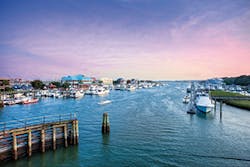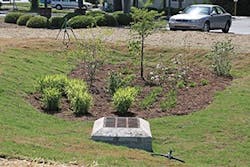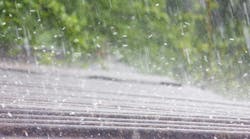“There are three reasons for us to do a stormwater project. One is to fix a flooding problem. Nine out of ten citizens would say this is the main reason. Two is to improve water quality,” says Dave Mayes, Stormwater Services Division manager for the city of Wilmington, NC.
“Three, we have a disjointed system. Part of it is under our control and part goes into private property. We want to develop a connected system, so with stormwater projects we can connect the dots.
“Every project we do relates to one or more of these factors, and if we do all three we’ve hit a home run,” he says.
“There are three reasons for us to do a stormwater project. One is to fix a flooding problem. Nine out of ten citizens would say this is the main reason. Two is to improve water quality,” says Dave Mayes, Stormwater Services Division manager for the city of Wilmington, NC. “Three, we have a disjointed system. Part of it is under our control and part goes into private property. We want to develop a connected system, so with stormwater projects we can connect the dots. “Every project we do relates to one or more of these factors, and if we do all three we’ve hit a home run,” he says. [text_ad] Located in coastal southeastern North Carolina, Wilmington has a population of 112,067 (2010 census). In 2014, Wilmington celebrated the 275th anniversary of its existence. City residents live between the Cape Fear River and the Atlantic Ocean. Four beach communities—Wrightsville Beach, Fort Fisher, Carolina Beach, and Kure Beach—are within half-hour drives of downtown Wilmington. During the Civil War, the city’s port played a critical role in supplying the troops and citizens of the Confederacy. Blockade runners—epitomized by Rhett Butler in Gone With The Wind—risked Union Army artillery for great profit. So well defended was Wilmington that it didn’t fall into Union hands until two months before the war had ended. [text_ad use_post='27751'] Wilmington’s connections to the Revolutionary and Civil Wars and its proximity to beaches make tourism an important part of the local economy. Another area attraction and economic contributor is commercial and recreational shellfishing. Untouched coastal landscapes in southern climates produce very little runoff. They have several built-in ways to reduce the volume of water and the pollution it carries. First is sandy soil that absorbs and filters runoff quickly. “Our soil is so sandy that we get 20 inch per hour infiltration. [Runoff from] a two-and-a-half-inch storm in 24 hours never touches the street,” says Jonathan Babin, stormwater manager for Wrightsville Beach. Plants that thrive in warm weather most of the year also absorb and filter stormwater. Finally, the heat evaporates runoff much more quickly than it can be evaporated in colder climates. But it’s the natural beauty of untouched coastal areas that attracts people and makes them want to settle there permanently. That means, of course, inevitable stormwater problems from more roads and roofs and other impervious surfaces. Such is the case with Wilmington and adjacent areas. Mayes sees two primary challenges for stormwater management in the area. “We’re getting above-average rainfall, 50 to 55 inches of rainfall per year. We get more volume of rain in storms, and the intensity is pretty high—a lot of rain in short duration.” He adds, “Combine that with very flat slopes. We have no ravines or steep hills. Water likes to hang out a lot longer, so we can’t move water from areas as quickly as you can in the Piedmont or mountainous areas [of North Carolina].” “It’s unlike point-source pollution. It’s everywhere, and its pathways are more direct, says Tracy Skrabal, coastal geologist and manager of the North Carolina Coastal Federation’s southeast regional office in Wrightsville Beach. “It’s the challenge and it’s also the objective, to disconnect the connections stormwater has [so that it will infiltrate onsite].” [caption id="attachment_31717" align="alignright" width="300"]Located in coastal southeastern North Carolina, Wilmington has a population of 112,067 (2010 census). In 2014, Wilmington celebrated the 275th anniversary of its existence.
City residents live between the Cape Fear River and the Atlantic Ocean. Four beach communities—Wrightsville Beach, Fort Fisher, Carolina Beach, and Kure Beach—are within half-hour drives of downtown Wilmington.
During the Civil War, the city’s port played a critical role in supplying the troops and citizens of the Confederacy. Blockade runners—epitomized by Rhett Butler in Gone With The Wind—risked Union Army artillery for great profit. So well defended was Wilmington that it didn’t fall into Union hands until two months before the war had ended.
Wilmington’s connections to the Revolutionary and Civil Wars and its proximity to beaches make tourism an important part of the local economy. Another area attraction and economic contributor is commercial and recreational shellfishing.
Untouched coastal landscapes in southern climates produce very little runoff. They have several built-in ways to reduce the volume of water and the pollution it carries. First is sandy soil that absorbs and filters runoff quickly.
“Our soil is so sandy that we get 20 inch per hour infiltration. [Runoff from] a two-and-a-half-inch storm in 24 hours never touches the street,” says Jonathan Babin, stormwater manager for Wrightsville Beach.
Plants that thrive in warm weather most of the year also absorb and filter stormwater. Finally, the heat evaporates runoff much more quickly than it can be evaporated in colder climates.
But it’s the natural beauty of untouched coastal areas that attracts people and makes them want to settle there permanently. That means, of course, inevitable stormwater problems from more roads and roofs and other impervious surfaces. Such is the case with Wilmington and adjacent areas.
Mayes sees two primary challenges for stormwater management in the area. “We’re getting above-average rainfall, 50 to 55 inches of rainfall per year. We get more volume of rain in storms, and the intensity is pretty high—a lot of rain in short duration.”
He adds, “Combine that with very flat slopes. We have no ravines or steep hills. Water likes to hang out a lot longer, so we can’t move water from areas as quickly as you can in the Piedmont or mountainous areas [of North Carolina].”
“It’s unlike point-source pollution. It’s everywhere, and its pathways are more direct, says Tracy Skrabal, coastal geologist and manager of the North Carolina Coastal Federation’s southeast regional office in Wrightsville Beach. “It’s the challenge and it’s also the objective, to disconnect the connections stormwater has [so that it will infiltrate onsite].”
This rain garden at Tidal Creek is a city stormwater project, part of the Grey to Blue program.
Skrabal adds, “Even though we’re a small town, we’re heavily populated. We’re surrounded by water everywhere—the river, tidal creeks, the ocean.”
On the plus side, she notes, “Our residential areas are very sandy and able to infiltrate stormwater well. With the correct application they are usually successful. We don’t have the difficulty [in infiltrating runoff] that you have in areas that have clay soils.”
Wilmington has a stormwater utility in place for both residential and commercial properties. There is no consent decree, but Wilmington and surrounding communities are working together to implement a long-term plan to restore the quality of impaired waters so that shellfishing areas can be reopened.
As for green infrastructure in stormwater projects, Mayes says, “We’re trying to incorporate it, and we’re at the beginning stages.”



